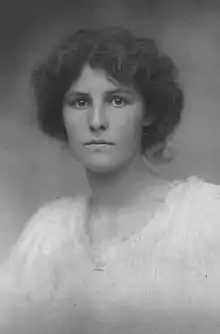Daphne Olivier | |
|---|---|
 Daphne Olivier | |
| Born | October 1889 |
| Died | July 1950 |
| Parents |
|
| Relatives | List
|
Daphne Olivier (October 1889 – 14 July 1950) was the third daughter of the British politician Sydney Olivier, 1st Baron Olivier, and Margaret Cox. She was the sister of Margery (1886–1974), Brynhild (1887–1935) and Noël (1893–1969), and the first cousin of the actor Laurence Olivier (1907–1989).[1][2] She established the first Rudolf Steiner school in England.
Biography
Daphne Olivier studied medieval and modern languages at Newnham College, Cambridge and, together with her sisters Bryn and Noël, belonged to the social circle that gathered around Rupert Brooke: a group that Virginia Woolf named the Neo-Pagans.[2] Olivier was also a friend of John Maynard Keynes.[3] Upon graduating in 1913, she became a teacher. Some years later, she developed an interest in the anthroposophical and educational work of Rudolf Steiner; according to Owen Barfield, she possibly attended an educational conference that Steiner held in Stuttgart in 1922. That same year she met both Barfield and his close friend Cecil Harwood at a concert tour of the English Folk Dance Society, where she sang and played the fiddle. It was through her that they both became acquainted with anthroposophy.[4]
Olivier approached Steiner for support in starting a Waldorf School in England, gathered a group of three other women and, on being advised by Steiner to include also a male teacher, asked her friend Harwood to join. The school, called at the time "The New School" was founded in 1925 in South London. It later moved to Forest Row in East Sussex and was renamed Michael Hall.[5] She and Harwood were married on 14 August 1925, and subsequently had five children.[1] Besides her work as a teacher, Daphne translated a number of Steiner's works into English.
Harwood was a friend of C.S. Lewis and Barfield, a fellow follower of Steiner. Lewis was a frequent visitor to the couple's home in London and became godfather to their son Laurence. She died in 1950 of cancer.
References
- 1 2 The Peerage
- 1 2 Paul Delany. The Neo-Pagans - Friendship and Love in the Rupert Brooke Circle. (1987 Macmillan London) p.230.
- ↑ Maynard Keynes: An Economist's Biography by Donald Edward Moggridge Routledge 1992 ISBN 978-0-415-05141-5, P. 213
- ↑ Owen Barfield: Romanticism Comes of Age : A Biography - Simon Blaxland-de Lange. Temple Lodge Publishing 2006 P.91
- ↑ Alfred Cecil Harwood
Bibliography
- Watling, Sarah (2019). The Olivier Sisters: A Biography. Oxford University Press. ISBN 978-0-19-086739-3. (alternative title: Noble Savages. The Olivier Sisters: Four lives in seven fragments)
- Delany, Paul. The Neo-Pagans - Friendship and Love in the Rupert Brooke Circle. Macmillan. London. 1987. ISBN 0-333-44572-4 (hc)
- C. S. Lewis, My Godfather: Letters, Photos and Recollections by Laurence Harwood, IVP Books 2007 ISBN 978-0830834983
- All My Road Before Me: The Diary of C. S. Lewis, 1922-1927 by C. S. Lewis; edited by Walter Hooper, HarperCollins 1991 ISBN 0-15-604643-1
- A Good School: A History of Michael Hall by Joy Mansfield; edited by Brien Masters and Stephen Sheen, Blue Filter 2014 ISBN 978-0956765345